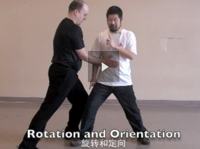I remember that when I was a young, I hated doing calligraphy. All my arm muscles including those of my shoulder and back would tense-up and hurt. I hated even more those lectures where teachers would spend the entire class making me take notes non-stop. But with time, my hand learned when not to involve my wrist, elbow and shoulder. And now as an adult who practiced writing for years, I can write for long periods of time without getting tired.
How does the process of learning Tai Chi Quan relate to learning how to write? Well, for those who are not ambidextrous (or cannot write with both hands with the same proficiency) can relate to this right away. Write a word with pen and paper using your dominant hand. Then write the same word again using your other hand and compare the feelings. You will notice how tense is your non-dominant hand and how much excessive of movement it makes.
One of the reasons is because some muscles of your non-dominant hand are not as developed as your dominant hand. But more importantly, your nervous system is not layered around those specific muscles you are calling for. You know how you want your non-dominant hand to move. But your hand won’t listen, nor do it the way you want it to. The lack of nerves around those muscles makes you give same command to the other muscles nearby in order to compensate for it; which is why the movements ends-up being excessive and tense.
This is also the reason why Tai Chi Quan focuses so much on the mind and intent. It is to develop the nervous system and ability to command our muscles; so that we can perform the corrected movements we want. Although the beginning it might be uncomfortable, tense and tiring; with patience and practice, we will develop the ability to move body without the tensions and excessive movements.
One thing you will notice when writing with your dominant hand is how small are your fingers and wrist movements compared to your other hand. The reason is because when using your dominant hand, you “control” the pen. But your non-dominant hand does not control the pen; it “drags” the pen into place. This dragging motion is also referred as “tossing”. You will notice that when trying to write with your non-dominant hand, your fingers draw what you want to write not your pen. Your pen just happens to be in the same place as the fingers and gets dragged along with it.
On the other hand (both ironically and literally, lol), when you write with your dominant hand; you pivot your pen up and down with your fingers. You use your wrist only when you write something curved and when you need to shift to the right for more space; you shift your elbow. This is an example of the classical saying of Tai Chi: “Use technique not force”. We need force to drag something along which becomes tense, but techniques are created so that hard-work become easier to execute.
Another Chinese old trivia and saying is: “You can tell how good a sword master is by his calligraphy”. This is true seeing how traditional Chinese characters are so complex to write. Not to mention that the ink pencils are long paint brushes.



{ 2 comments… read them below or add one }
Interesting comparison
your article makes a lot of sense…..I have a student who teaches calligraphy….one day I used Taijiquan principles and logic to describe the necessary components of good calligraphy….my student was amazed and said that I was basically describing many of the intricacies of quality calligraphy…I encouraged her to take some of the lessons learned in Calligraphy and try to use that information in improving her form….my experience is that high level arts have much in common…